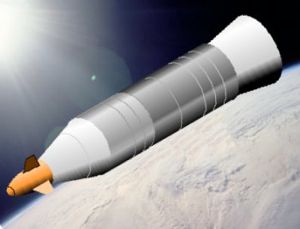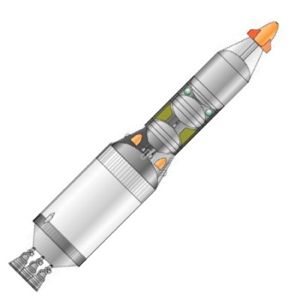
Home - Search - Browse - Alphabetic Index: 0- 1- 2- 3- 4- 5- 6- 7- 8- 9
A- B- C- D- E- F- G- H- I- J- K- L- M- N- O- P- Q- R- S- T- U- V- W- X- Y- Z
Manned Venus Orbiting Mission
 Venus Manned SC Manned Venus Orbiting Mission Credit: NASA |
Status: Study 1967. Gross mass: 54,400 kg (119,900 lb). Height: 28.00 m (91.00 ft). Diameter: 6.90 m (22.60 ft).
The study looked at a manned orbiting stopover round-trip mission to Venus in the 1975 to 1980 time period. A typical trip in 1980 had the following characteristics:
- Total trip time: 565 days
- Stay time at Venus: 40 days
- Earth atmosphere entry velocity: 47,000 fps
- Venus parking orbit: Periapase, 1.1 Venus radii; Apoapse: 20.9 Venus radii.
- Time below 3 Venus radii: 2 days
- Initial weight in Earth orbit with Apollo level of technology: 800,000 to 1.4 million pounds depending on launch opportunity and mission profile.
- Essential to achieving low initial weights was a highly elliptical (e=0.9) parking orbit at Venus.
- The elliptic parking orbit might adversely affect information gathering. Further study of the best tradeoffs between parking orbit ellipticity , stay time at Venus, and weight of observation equipment was required.
- A Venus mission could be accomplished using Apollo level technology. S II stages could possibly be used for the Earth departure maneuver.
- One new stage using Earth-storable propellants was required for the Venus arrival and departure maneuvers.
- While the Venus orbiting mission could be accomplished using the Apollo level of technology, reductions in weight were possible using advanced propulsion. For example, using a nuclear rocket stage for the Earth departure maneuver could reduce the initial gross weight by 30 percent. If, in addition, OF2-CH4 stages were used for the maneuvers to arrive and depart Venus, a total weight reduction of 50% was possible.
- A single vehicle design for the 1980 launch opportunity could accomplish the Venus mission in any other synodic period.
- To accomplish a Mars orbiting mission in the easiest year would require a vehicle 70% heavier than that for the Venus orbiting mission in the most difficult year. The disparity could be much larger in other years.
- Earth Re-entry vehicle (included crew and stored data - the mass matches an Apollo CM, but the sketch of the design shows a lifting body with two vertical stabilizers): 14,000 lbs
- Life Support module: 66,000 lbs + 50 lbs/day consumables
- Scientific payload to Venus orbit: 30,000 lbs
- Venus atmospheric entry probes:10,000 lbs
Family: Venus. Country: USA. Bibliography: 2034.
 | Venus Manned SC Manned Venus Orbiting Mission Credit: NASA |
Back to top of page
Home - Search - Browse - Alphabetic Index: 0- 1- 2- 3- 4- 5- 6- 7- 8- 9
A- B- C- D- E- F- G- H- I- J- K- L- M- N- O- P- Q- R- S- T- U- V- W- X- Y- Z
© 1997-2019 Mark Wade - Contact
© / Conditions for Use